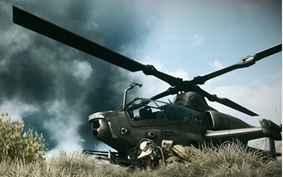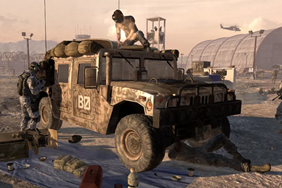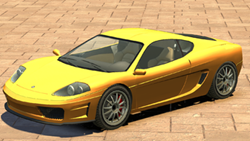When 3-D Objects in Video Games Pose IP Challenges
Monika A Górska
Wardyński & Partners, Warsaw
monika.gorska@wardynski.com.pl
Lena Marcinoska-Boulangé
Wardyński & Partners, Warsaw
lena.marcinoska@wardynski.com.pl
Video games often include real-life 3D objects, particularly if the game is to be realistic. These can be vehicles, clothing, furniture, weapons, electronics equipment or other items that become an integral part of the game’s world. The trouble with real-life objects is that they may be protected by various intellectual property rights, such as trademark or trade dress,[1] copyright, design, or fair competition rules. Unless the right holder has consented to the real-life object being used in the game, the game’s developer or publisher risk infringing IP.
Furthermore, as video games are enjoyed globally but IP is territorial, there are different rules as to what constitutes an infringement and the defences available in such a claim. Reported cases of infringements of IP due to using real-life objects in video games reveal some fascinating insights.
Please note that this article does not consider the use of real-life architectural works in video games because, depending on jurisdiction and conditions, these could rely on freedom of panorama.[2]
In-game helicopters and military vehicles battle the First Amendment in the US courts
At least two reported cases in the United States have gaming and legal practitioners talking. The first contribution to case law on IP infringements in video games involved the use of Bell AH-1Z, UH-1Y and V-22 helicopters in the Battlefield 3 video game, published by Electronic Arts Inc (EA).[3]

Figure 1: example use of Bell helicopter in Battlefield 3.
EA were intending to pay a licence fee for the use of Bell helicopters; however, negotiations with Textron, the rights holder to Bell helicopters’ trade dress and trademarks, stalled and the publisher released the game anyway. As for the helicopters’ depiction, Textron[4] relied on a trade dress infringement and claimed that the designs and shapes of certain elements of Bell helicopters were used without consent.
EA relied on a First Amendment defence,[5] specifically the Rogers Test,[6] arguing that a trade dress infringement did not apply if the use had no artistic relevance to the underlying work, or, if it had some artistic relevance, as long as the use was not explicitly misleading as to the source or content of the work.[7]
Textron argued that EA was using Bell helicopters not only in the game but also in its advertising, and therefore confusing consumers as to the source, affiliation or sponsorship of the game.[8] Textron also claimed that consumers of games expect that if a real-life object is used, it has the right holder’s consent. Accepting Textron’s arguments, the judge noted that the use of Bell helicopters was not incidental: in fact, the opportunity to ‘fly’ Bell helicopters could be one of the game’s selling points.[9] Therefore, it was plausible that consumers could believe that Textron had provided expertise and knowledge to create a realistic simulation of the actual workings of Bell helicopters. The case was eventually settled out of court.
The second case concerned the use of a US military vehicle, colloquially named ‘Humvee’,[10] in the Call of Duty video game, published by Activision Blizzard Inc and Activision Publishing Inc (Activision).

Figure 2: example use of Humvee in Call of Duty.
Humvee’s right holder is AM General LLC (AMG), which was the first contractor to build the vehicle for the US Department of Defense. AMG sued Activision for using Humvees in a game and allegedly infringing, among others, trademarks, trade dress and fair competition rules. Humvees were depicted in Call of Duty in various ways and for various durations. Sometimes, they would appear briefly in the background; at other times, players could ride and control them, or to progress to the next level of a game, a player would need to interact with one. Humvees also appeared in trailers to advertise the game and in guides to it. Activation even licensed a toy company to manufacture branded game construction sets, two of which included a toy vehicle.
The matter took a totally different direction than the Bell case. The District Court in New York[11] held it permissible to depict Humvees in Call of Duty. The Court also relied on the Rogers Test, but concluded that the use of Humvees had artistic relevance. Their use gives players an opportunity to take part in a Special Forces operation and help increase the game’s realism. The Humvee is what a real soldier would expect to see in that sort of situation, time and place. In applying the Rogers Test, the Court found in particular that it was not misleading to use Humvees in games, because AMG’s and Activision’s Humvees had different purposes, they did not compete with each other and the use of Humvees in games was motivated by artistic, rather than commercial, considerations.
Both cases debated the artistic relevance of using real-life objects and showed that ‘freedom of speech’ changes with time. While the earlier Bell matter regarded the use of helicopters in a game as an infringement, in the later Humvee case, the Court, surprisingly, deemed the use as falling within freedom of speech. Irrespective of that, the First Amendment and the Rogers Test seem to be the main primary defences in such cases.
In-game cars lose verve in the courts of the European Union
Ferrari Spa (Ferrari) sued, inter alia, Take Two Interactive France, the publisher of Grand Theft Auto games[12] for the use in Grand Theft Auto 4 of a car named Turismo. Ferrari claimed Turismo was made as a likeness of a real-life car, the Modena 360, and included a combination of its characteristic features.[13] Ferrari invoked registered designs, including DM/043107 and DM/043108 and the copyright to Modena 360, claiming that the car’s model reflected the author’s personality, was original and could therefore be protected by copyright.[14]

Figure 3: example photo of a real Ferrari Modena 360

Figure 4: example photo of the game’s Turismo car


Figure 5: example design DM/043107 and DM/043108
An unauthorised reproduction of a real Ferrari could constitute an infringement of copyright and designs; however, in this case, there were significant differences between the game’s car and the real one. The court concluded that the game’s Turismo had not copied essential features of the Modena’s 360 and dismissed the lawsuit.[15] Differences in appearance prevailed in the Ferrari matter. But if Turismo had been a direct reproduction, or had been deemed closer to Modena 360, the outcome may have been different.
The Ferrari matter also involved unfair and parasitic competition and infringement of rights to the company’s image. Ferrari argued that the luxurious allure of the game’s car, the similarity of the real car and the game’s car, the car’s logos (a horse) and the font of the logo in the game, as well as the similarity of the game car’s name and its technical features, took unfair advantage of Ferrari’s recognisability and misled gamers into presuming that Ferrari had endorsed the game.[16] However, the elements that Ferrari relied on were found not to evoke associations with Ferrari nor mislead gamers nor take unfair advantage of Ferrari’s recognisability. The alleged brutality and vulgarity in the game that might have a negative impact on consumers’ perception of Ferrari was also dismissed as unfounded.
The differences between an IP-protected object and the infringing object always mean that any assessment is debatable, whether the matter involves a game or the traditional sector. There is always a fine and difficult-to-establish line between unauthorised reproduction (or modification) and permissible inspiration (or non-confusing similarity).
Public domain, open licences and freedom of artistic expression
Obviously, it is best to avoid the risk of infringing IP. One approach is to use objects the IP rights of which have expired and are in the public domain. As for copyrightable objects, museums worldwide provide assistance and information on which objects in their collections are now in the public domain. This may be a safe way of using real-life objects in games, such as weapons, old military vehicles, furniture, costumes or historic everyday items, etc.
Objects are sometimes made available for use under Creative Commons licences. Nevertheless, it is essential that the terms of such licences are checked, in particular as to whether they permit commercial use or the making and disseminating of modifications.
In EU matters on trademarks used in games, the main issue that a court is likely to consider will be whether such use of the trademark in the game is use of the trademark in the function of a trademark, that is, for designating goods and services. An interesting question is also whether the use in a video game of a real-life 3D object could be excused based on freedom of artistic expression. The answer depends on the circumstances and type of IP right. Depending on the jurisdiction and conditions, for example, fair use doctrine, a use for other than distinguishing goods or parodying an IP-protected real-life object could be allowable excuses. In a recent case involving the well-known Dom Perignon trademark, used by an artist in a painting,[17] the court observed that trademark law should not hinder use of the trademark in artistic expression, which as a part of freedom of expression, is protected by Article 1 of the European Convention on Human Rights, as long as such use accords with honest practice in industrial and commercial matters.[18] Therefore, use of a trademark other than for distinguishing goods or services is allowable, if the artistic expression is the original result of a creative design process that does not aim to harm the trademark or the trademark’s holder. It remains to be seen whether this approach could apply in other matters.
In-game advertising
Another solution is, of course, to obtain a licence from the right holder. Even AMG claimed that at least four other video game developers, aside from Activision, had featured Humvees in their games under licences. As it is clear that video games are a growing media platform and advertising channel, a licence could be part of a wider agreement concerning in-game advertising. In-game advertising is the placement of goods or services in a video game, usually so they become an integral part of the universe and have a dynamic function in the game (eg, characters use them or interact with them). Racing games (such as Need for Speed, where players can drive a BMW, Nissan or Porsche) are typical productions that use in-game advertising. The player’s avatar in the longstanding production Tom Clancy’s Splinter Cell: Pandora Tomorrow uses Sony Ericsson phones to take pictures of terrorists and transmit their photos to headquarters for identification, and to communicate with other characters. In The Sims, a player can use a Renault Tizzy electric car to increase the Sims’ prestige and optimise expenses.
A number of issues must be considered in an in-game advertising contract to avoid problems, such as undertakings on the use in the game of the real-life object and the context of its use. Alan Wake is a good example. When moving in darkness, the main character uses a magic torch (or flashlight) that protects him against dangers. The torch is powered by Energizer batteries. The problem was that the batteries quickly ran out in the game. Players gained an impression that Energizer batteries were poor quality. This blunder could have been avoided if the life of the batteries and their other features had been specified in the contract.
Summary
The use of real products or objects in video games increases their realism and helps to immerse players in the game’s world. This is an important element of sports games, historical games, racing games, simulators and all other games set in the present. It is, therefore, expected that the uses of real objects in games will only increase and, consequently, more matters could end up in courts. The cases that have been described above demonstrate that the approach of courts fluctuates, and rulings could be uncertain for either party. An alternative is to acquire authorisation to use certain objects in games or to create them independently. Though, the latter option also carries risk, particularly if the created object is still similar to that which is protected by IP, and transgresses permitted boundaries.
Notes
[1] Trade dress, sometimes called ‘get-up’, is the overall commercial image (look and feel) of a product or service that indicates or identifies the source of the product or service and distinguishes it from others. Depending on the jurisdiction, it may include, eg, the design or configuration of a product, the packaging of goods, or the décor or environment in which services are provided. Trade dress can consist of such elements as size, shape, colour, texture, etc, to the extent such elements are not functional. See INTA ‘What is trade dress?’, www.inta.org/topics/trade-dress accessed 3 July 2021.
[2] Lena Marcinoska-Boulangé, ‘Freedom of panorama’ Codozasady (22 October 2015) https://codozasady.pl/en/p/freedom-of-panorama; Ewa Nagy, ‘Law vs. Imagination’ Codozasady (16 July 2020) https://codozasady.pl/en/p/prawo-kontra-wyobraznia; Wikipedia, ‘Freedom of panorama’ https://en.wikipedia.org/wiki/Freedom_of_panorama accessed 3 July 2021.
[3] Electronic Arts, Inc v Textron, Inc et al, https://cases.justia.com/federal/district-courts/california/candce/3:2012cv00118/250492/79/0.pdf?ts=1428823200 accessed 3 July 2021.
[4] The cause of action were trademarks and trade dress, in which Textron Innovations Inc and Bell Helicopter Textron Inc were the claimants.
[5] First Amendment to US Constitution: ‘Congress shall make no law respecting an establishment of religion, or prohibiting the free exercise thereof; or abridging the freedom of speech, or of the press; or the right of the people peaceably to assemble, and to petition the Government for a redress of grievances’ https://constitutioncenter.org/interactive-constitution/amendment/amendment-i accessed 3 July 2021.
[6] Wikipedia, ‘Rogers v Grimaldi’ https://en.wikipedia.org/wiki/Rogers_v._Grimaldi accessed 3 July 2021.
[7] Ginger Rogers v Alberto Grimaldi, Mgm/ua Entertainment Co, and Pea Produzioni Europee Associate, SRL, 875 F.2d 994 (2d Cir 1989), www.courtlistener.com/opinion/524053/ginger-rogers-v-alberto-grimaldi-mgmua-entertainment-co-and-pea accessed 3 July 2021.
[8] Textron’s trademarks and trade dress of helicopters were used on the Battlefield 3 website. Bell’s helicopters were ‘given particular prominence’ and the opportunity to use a Bell helicopter was promoted to consumers.
[9] The judge also considered EA’s argument of a ‘nominative fair use’ of trademarks, which occurs ‘where the only word reasonably available to describe a particular thing is pressed into service and therefore, such use is fair because it does not imply sponsorship or endorsement by the trademark holder’. The judge rejected EA’s argument.
[10] ‘Humvee’: High Mobility Multipurpose Wheeled Vehicle.
[11] Case 1:17-cv-08644-GBD-JLC document 218, filed 31 March 2020 https://digitalcommons.law.scu.edu/cgi/viewcontent.cgi?article=3188&context=historical accessed 3 July 2021.
[12] Court of Cassation, Civil, Commercial Chamber, 8 April 2014, 13-10.689, unpublished, www.legifrance.gouv.fr/juri/id/JURITEXT000028848928; Paris Court of Appeal, Pôle 5, 26 January 2016, No 2014/10931 www.doctrine.fr/d/CA/Paris/2016/INPID20160006 accessed 3 July 2021.
[13] Also Modena 360 Challenge, F40, F40 Competizione; Paris Court of Grande Instance, Judgment delivered on 25 November 2010 http://inpi.doctrine.fr/D20100286.pdf accessed 3 July 2021.
[14] Ibid.
[15] Court of Cassation, Civil, Commercial Chamber, 8 April 2014, 13-10.689, unpublished, see www.legifrance.gouv.fr/juri/id/JURITEXT000028848928 accessed 3 July 2021.
[16] Paris Court of Appeal, Pôle 5, 26 January 2016, No 2014/10931.
[17] TaylorWessing, ‘The intersection between artistic expression and trade mark rights’, 9 April 2020 www.taylorwessing.com/de/insights-and-events/insights/2020/04/the-intersection-between-artistic-expression-and-trade-mark-rights accessed 3 July 2021.
[18] Léon Dijkman ‘Benelux Court of Justice rules on use of a well-known trade mark in a work of art’ (The IPKat, 2 November 2019) https://ipkitten.blogspot.com/2019/11/benelux-court-of-justice-rules-on-use.html accessed 3 July 2021.